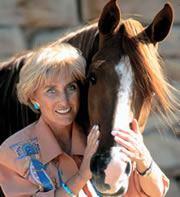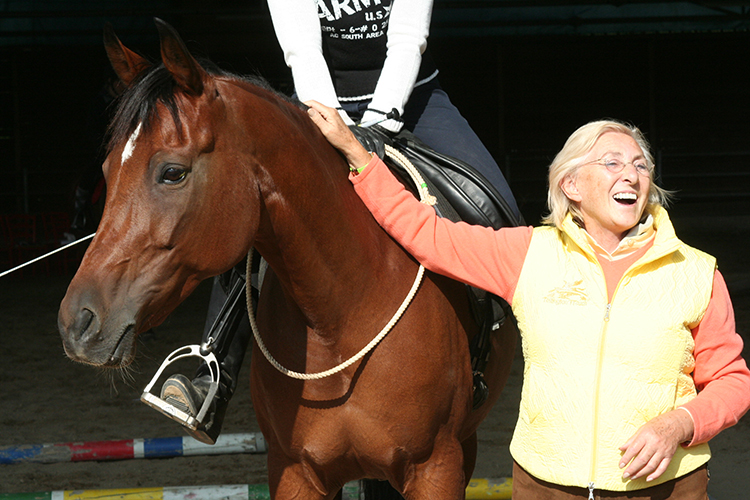Who's Who

Tellington-Jones, Linda
Discipline : Horsemanship
Born : 1937
She was born Linda Hood and grew up in Edmonton, Alberta, a typical pony mad kid with an added edge of intensity. By the time she was eleven, Linda would ride her pony home from school, then head to Briarcrest Stables where she would ride another three or four horses – usually the ones that had bucked off their riders. “I was fortunate to ride for five years under the tutelage of Alice Greaves Metheral, a leading hunter-jumper trainer of the day,” says Linda told Bonnie Lieberman of EQUUS magazine, in an article published in 2007, “My other good fortune was that during the winter we had education classes, where we learned details from the British Horse Society about training, breeding, judging, conformation, tack and breeds. It was a wonderful foundation when I became a US Pony Clubs instructor and opened my own school for riding instructors.”
By the time she was twelve, she broke in her first horse – and found that by long reining it from the ground, she could get on with no bucking. She was already instructing other riders, and had begun a showing career, that saw her win the Calgary Herald Challenge Equitation Trophy three years in a row by the time she turned 15.
Linda became an all-round competitor: endurance, eventing, dressage, Western, jumping and even steeplechasing. She completed her first of five Tevis Cup 100-mile rides in 1960, with her Arabian mare, Bint Gulida. Linda’s grandfather, Will Caywood was a huge influence on the development of her training philosophy:
“My grandfather believed in letting a horse get used to you in his own time to develop a common trust.” Mr Caywood hummed, sang and whistled to horses to calm them and develop a relationship with them. He also introduced his granddaughter to the idea of using massage to improve their performance.
Linda’s first husband, Wentworth Tellington had a decisive rôle. He graduated as an officer in the last US Cavalry class and there he learnt to ride as part of a team, making their way around obstacles as cannons were fired. This became the basis of Linda’s Playground for Higher Learning, a course of obstacles that teaches confidence and cooperation.
“When I began developing ground exercises,” Linda told Bonnie, “I found that horses learned much faster when worked through a maze of six 10-foot ground poles that we call the Labyrinth.”
In 1961, Linda established the Pacific Coast Equestrian Research Farm and School of Horsemanship, a nine-month residential school for riding instructors, in California. The students were required to show in Western pleasure and hunter classes, achieve at least a 50 percent score in a First Level dressage test, complete a 50-mile endurance ride and start a young horse without bucking.
By the mid-70s Linda decided she needed a break and set off to travel the world. “I sold 60 horses and equipment and vans, and headed for Europe.”
Linda quickly gained acceptance in Germany after she appeared at Equitana, where Linda and three of her pupils, jumped obstacles and performed drill maneuvers while mounted on horses wearing neither bridles nor saddles. It was a big hit. After that, Linda was invited to demonstrate her methods in Germany, Austria and Switzerland, and by 1975 she had devised her weekend sessions that emphasized fun and stress free learning. The famous TTEAM or Tellington Equine Awareness Method was born.
One of the trainers Linda worked with was Klaus Balkenhol, in his biography, he talks about what he learned: In order to better understand Gracioso’s, Goldstern’s, and Farbenfroh’s neuroses, Klaus Balkenhol turned to world-renowned horse trainer and animal behaviorist Linda Tellington-Jones, whose unique form of bodywork and training is reputed to override common resistances and strengthen the horse-human bond.
“It was quite astonishing to see how much the horses changed,” he remembers, laughing at the memory of an episode with Goldstern. “When Linda worked with Goldstern, he was suddenly transformed, standing there with his ears and neck drooping, totally relaxed. The next day, he was still so relaxed, he didn’t go well at all — because now he was lacking the necessary body tension to perform. I said to Linda, ‘I guess this didn’t work out! Do you think you could change the dose so he’s relaxed but doesn’t fall asleep?’
“The result was incredible. During the next session she worked with ‘Goldi’ in a slightly different way, and the following day he was just sensational.”
Klaus also used the Tellington Method with the 2002 world champion dressage horse, Farbenfroh: “We worked a lot on helping him get over his ground shyness. We had him step over plastic sheets, and other strange objects or surfaces. And I’m sure I’ve dragged the centerline thousands of times at home because he shied from – or jumped over – the dragged centerlines in competition arenas.”
In the mid-70s, Linda came under the influence of the learning theory of Israeli physicist Moshe Feldenkrais. She realized that his concept of reeducating the nervous system without fear or force could be applied to animals to overcome resistance, stress and tension and improve coordination and learning ability.
Linda suggested that unwanted behavior in horses is often related to back or neck pain. “Who thought about checking a back or neck in relation to undesirable behavior?” she says. “If a horse refused to do something, you just got after him harder with a whip or spur. Today, we check the body to see where there may be areas of soreness or memory of past trauma or injury-holding patterns of tension that can be the cause of resistance or behavior problems.”
But there was another element to the TTEAM approach added to the repertoire in 1983 when Linda was asked to work with a bad tempered mare, who disliked being groomed and saddled. Quietly Linda began to massage the mare, and she started to relax. Her owner wanted to know the secret: “Don’t worry about what I’m doing, just put your hands on your horse and push the skin in a circle.”
Light, single press-and-release circles with the fingertips and hands were not – until that day – a part of her method, but Linda realized that something quite special was happening and that she needed to explore these circular touches. She believes the circles release fear at the cellular level, leaving room for a new level of confidence and expression. The technique soon acquired 20 variations, with such exotic names as the Python Lift, Lick of the Cow’s Tongue and Inch Worm.
In 1988, Linda published her first book, An Introduction to the Tellington-Jones Equine Awareness Method. She summed up the approach in the introduction: “We have discovered over 25 years that we can educate horses with a combination of bodywork to bring awareness, ground exercises to develop new levels of coordination and cooperation, and exercises under saddle that give the rider new tools to improve performance without repetition.”
Bonnie Lieberman summed it up well in her EQUUS article:
Linda Tellington-Jones believes that by treating a horse as you would like to be treated – what she calls the Equine Golden Rule – we enhance our relationship with those of our own species. “Seeing horses as our teachers awakens a level of trust, relationship and respect that goes both ways, and in so doing, shifts our relationship to the world,” she says. “This acknowledges and heightens our spiritual relationship with the horse, bringing us home to the same radiance that first drew us to the equine spirit.”
Linda has written 21 books about TTouch and TTEAM which have been printed in twelve languages. Her most recent is Dressage with Body, Mind & Soul: A 21st-Century Approach to the Science and Spirituality of Riding and Horse-and-Rider Well-Being by Linda Tellington-Jones with Rebecca M. Didier, published in 2013.
You can find out much more about Linda Tellington-Jones on her website: www.ttouch.com

